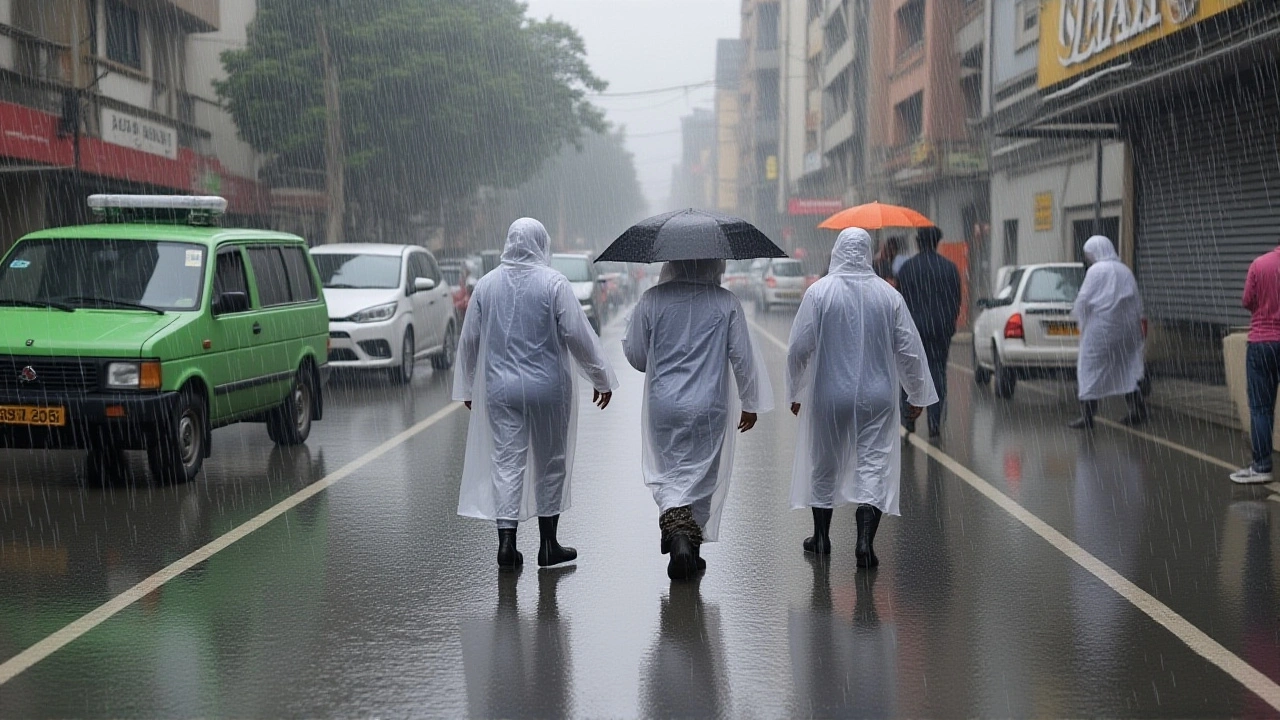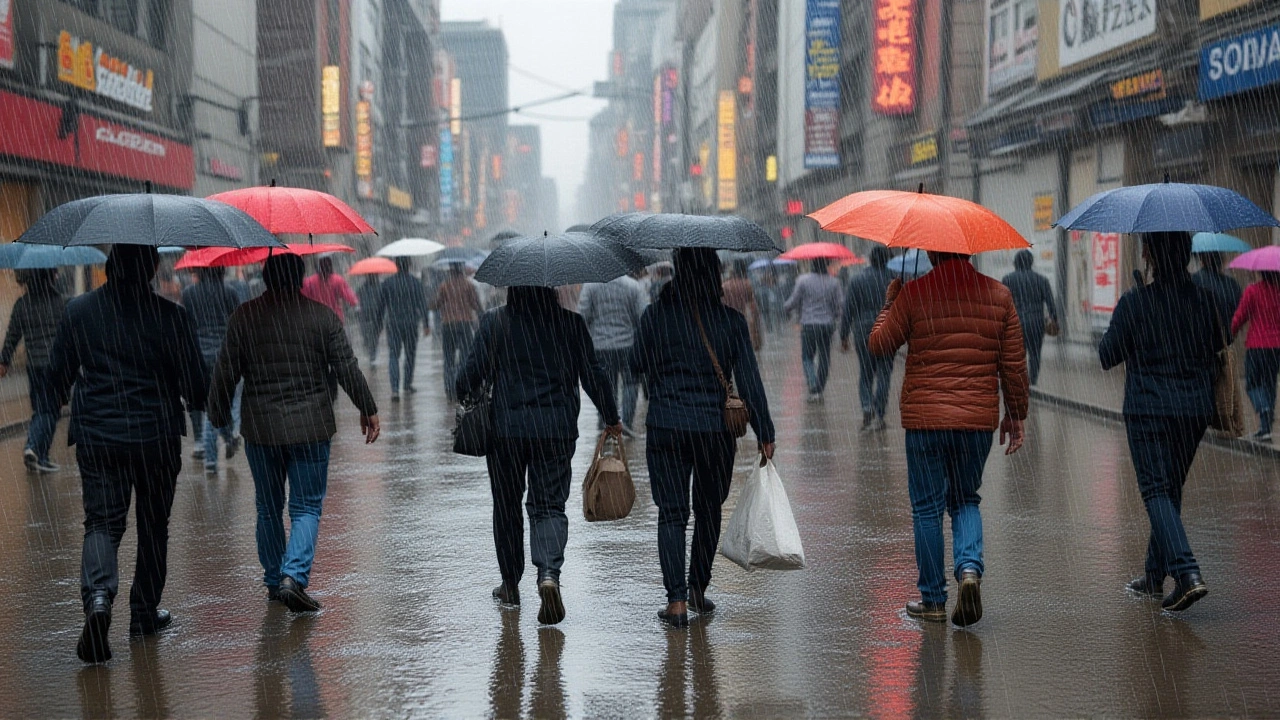When Kenya Meteorological Department released its seven‑day outlook on , residents from the coastal belt to the far‑flung north‑west braced for an unusually wet spell. The department’s official statement warned that heavy rainfall would drench five distinct regions of Kenya from that Tuesday through Sunday, October 6, bringing daytime highs above 30 °C in some locales while night‑time lows could plunge below 10 °C in the arid north. Faith Chandinya, a reporter for TUKO.co.ke, was on the scene to translate the technical bulletin into everyday terms, and her colleague Jackson Otukho later fine‑tuned the copy before publication.
What the Forecast Says
The KMD’s seven‑day forecast – officially titled 7‑day Heavy Rainfall WarningKenya – outlines a band of intense precipitation that will sweep across the country’s southern, central, and north‑eastern zones. According to the data, rainfall totals could exceed 120 mm in counties such as Mombasa and Kwale, while the highlands of Kericho may see 80 mm. The bulletin stops short of naming every county, but the five regions highlighted are the coastal strip, the western highlands, the Rift Valley, the north‑eastern semi‑desert, and the north‑western plateaus.
Regional Temperature Extremes
Temperature swings are stark. In the Coastal region of Kenya, daytime mercury is projected to reach 32 °C on Thursday, driven by humid sea breezes. Conversely, the Northeastern Kenya will experience night‑time lows of 8 °C on Saturday, a rare chill for an area that usually basks above 18 °C even after dark. The Northwestern Kenya isn’t spared either; temperatures there could dip to 9 °C, making early‑morning farming tasks hazardous.
Official and Expert Reactions
Speaking at a press briefing, John Mwangi, spokesperson for the Kenya Meteorological Department, urged the public to heed the warnings: “We’ve modeled the system using the latest satellite data. The rains will be intense, and the temperature contrasts could exacerbate flood risk in low‑lying areas.”
Climate specialist Dr. Amina Hassan of the University of Nairobi added, “This pattern aligns with the East African ‘short‑rain’ season but is amplified by a strong Indian Ocean Dipole. Communities should prioritize drainage clearing and protect livestock from the cold nights.”
Impact on Communities and Infrastructure
Farmers in the Rift Valley are already scrambling to move grain stores to higher ground. “If the fields flood, we could lose a season’s yield,” lamented Samuel Otieno, a small‑holder in Naivasha. Transport officials in Nairobi have warned that roadworks along the Nairobi‑Mombasa highway may be delayed, and traffic snarls could become the norm as slick surfaces give way to mud‑slides.
Health workers are also on alert. The Ministry of Health’s regional director for the north‑east, Grace Njoroge, reminded residents of the danger of water‑borne diseases: “Stagnant pools are breeding grounds for cholera. We’re distributing water purification tablets in the hardest‑hit districts.”
Preparing for the Week Ahead
- Secure loose roof tiles and clear gutters to avoid roof‑collapse.
- Store emergency rations and drinking water in sealed containers.
- Farmers should elevate equipment and consider temporary shelters for livestock.
- Motorists must reduce speed on wet roads and keep headlights on.
- Residents in flood‑prone zones should identify evacuation routes now, not later.
Local councils across the five regions have already activated their disaster response units. In Mombasa County, the emergency operations centre will operate 24/7, coordinating with the National Disaster Management Authority to issue real‑time alerts via SMS and radio.
What’s Next?
The KMD will issue a mid‑week update on Thursday, October 2, to refine rainfall estimates based on the latest satellite passes. If the system intensifies, a supplementary warning could expand the affected area to include the central highlands of Nyandarua and Karu. For now, the message is clear: stay informed, stay prepared, and heed the advice of officials before the skies open up.

Frequently Asked Questions
How will the heavy rainfall affect farmers in the Rift Valley?
Farmers risk losing crops to water‑logging, especially if fields flood before harvest. Authorities advise elevating storage bins and moving seedlings to higher ground. Extension officers are distributing sandbags in Naivasha and Nakuru to protect plots.
What safety measures are recommended for the cold nights in the north?
Residents should keep indoor heating sources safe, wear layered clothing, and ensure that livestock have insulated shelters. Health officials are providing thermal blankets in Kitale and Lodwar to reduce hypothermia cases.
Will the rain increase the risk of flooding in major cities?
Yes. Nairobi’s low‑lying suburbs and Mombasa’s coastal flats are prone to flash floods. City councils have pre‑positioned sandbags and are clearing drainage channels. Citizens should avoid walking through standing water, which may be contaminated.
What does the temperature swing mean for daily life?
The contrast means people may need both sunscreen for scorching midday heat on the coast and warm clothing for chilly evenings up north. Energy suppliers have warned of higher demand for electricity and firewood, so budgeting accordingly is wise.
When will the next official weather update be released?
The Kenya Meteorological Department plans a follow‑up bulletin on Thursday, October 2, incorporating the latest satellite imagery. If conditions change dramatically, an emergency notice may be issued before the weekend.


Joe Delaney
October 3, 2025 AT 01:08Looks like a tough week ahead for Kenya the rain will hit coastal areas and the highlands hard
Ruben Vilas Boas
October 13, 2025 AT 11:08Good heads up everybody stay safe clear gutters and move livestock to higher ground
George Thomas
October 23, 2025 AT 21:08The meteorological bulletin presents a significant hydrological event across multiple agro‑ecological zones. Stakeholders should integrate the forecast into existing risk mitigation frameworks. Coordination among local authorities will be pivotal to reduce potential socioeconomic impacts.
Michelle Linscomb
November 3, 2025 AT 06:08This deluge will wreck crops and livelihoods unless immediate protective measures are taken
John McDonald
November 13, 2025 AT 16:08From a climatological systems perspective, the synoptic trough is poised to enhance precipitable water vapor fluxes, translating into robust convective activity. Leveraging advanced hydrological modeling can optimize reservoir management and sustain agricultural output.
Jordyn Wade
November 24, 2025 AT 02:08The forecast underscores a marked thermal gradient between the coastal belt and the northern plateau. Such diurnal contrasts exacerbate convective instability. Rural communities are advised to reinforce structural shelters. Early warning dissemination will mitigate health hazards.
Zoe Birnbaum
December 4, 2025 AT 12:08Wow that’s a massive swing in temps! Hope everyone packs both sunscreen and a jacket.
Amber Brewer
December 14, 2025 AT 22:08The Kenya Meteorological Department’s outlook indicates a high probability of sustained precipitation across the specified regions.
Historical analogs suggest that similar events have resulted in localized flooding, particularly in low‑lying urban catchments.
It is advisable for municipal engineers to inspect drainage infrastructure before the onset of heavy rains.
Agricultural extension services should distribute sandbags and provide guidance on elevating storage facilities.
Livestock owners need to secure adequate bedding and consider temporary shelters to protect animals from nighttime chills.
Public health officials must preposition water purification tablets to reduce the risk of water‑borne diseases.
Road maintenance crews should prioritize clearing debris from major highways to prevent traffic disruptions.
Schools in the affected districts might need to adjust schedules or shift to remote learning if flooding impedes access.
Residents are encouraged to develop personal emergency kits that include non‑perishable food, flashlights, and batteries.
Communication channels such as SMS alerts and community radio can disseminate real‑time updates effectively.
Energy providers should anticipate increased demand for heating in the northern zones and plan accordingly.
Insurance agencies may consider temporary policy adjustments to accommodate potential crop losses.
NGOs operating in the region could coordinate relief efforts with local councils to streamline resource distribution.
Monitoring of river levels should be intensified to provide early warnings of flash flood conditions.
Overall, a coordinated multi‑sector response will be essential to minimise socioeconomic disruption caused by the upcoming heavy rainfall.